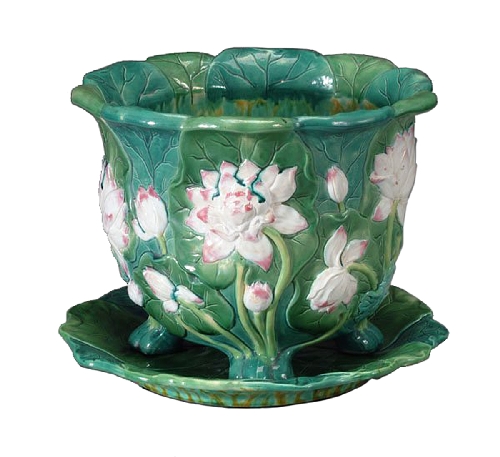Renaissance inspired pottery revival
The 1851 Crystal Palace Exhibition in London included the introduction of many amazing new products, one of them the revival of majolica. In the 19th century, Italian pottery of the Renaissance era was being studied and collected by English museums. England's Minton factory made a copy of the old designs and glazed them in a similar way. The clay was covered with an opaque white glaze, then painted freehand with bright colors.
Minton's majolica was displayed at the 1851 exhibition, and by the 1870s the company was making original designs inspired by Italian majolica. Its work was copied by many English, European and American makers. Later, Minton made majolica using colored glazes painted directly on the clay body. Designers made fanciful pieces like teapots with monkey handles; pitchers featuring birds, fish, shells and flowers; urns held by swans; tables held by monkeys; and jardinieres decorated with all types of flowers, birds and trees.
Majolica went out of fashion in the 1940s, when the beige, uncluttered look was "in." The colorful look did not come back until the 1990s.
Today, majolica made by any manufacturer is popular with collectors. Prices continue to rise. The colors and shapes seem to fit into today's styles.
Q: I have had a wooden table for more than 30 years and was about to give it to my daughter when she turned it over and found a mark. The marks says, "Sept. 29, 1896, 568397, Conrey -- Birely Table Co." Is my table older than I thought?
A: Your table is more than 100 years old. The patent was granted to Charles Birely for a method of attaching legs to furniture. Birely lived in Shelbyville, Ind., at the time he applied for the patent and had already been in the furniture business with Jacob A. Conrey for 10 years. The Conrey-Birely Table Co. had manufacturing facilities in Shelbyville and in Grand Rapids, Mich., until about 1909.
Q: We have a collection of World War I postcards from Germany and Holland. Are they worth anything? I expect that some of the buildings shown were destroyed in the war or later during World War II.
A: A postcard can sell for anywhere from 5 cents to several hundred dollars. The price is determined by the type of picture on the card, the artist or manufacturer, condition and rarity. Even the stamp or postmark can contribute to the value.
Cards with pictures of street scenes with stores, advertising, people or special events are very collectible. Collectors also look for pictures of early autos, trains or airplanes. You can go to a postcard show and see what cards like yours are selling for. Dealers may be interested in buying your cards but will pay you a lot less than the retail value. They have to make a profit.
Terry Kovel's column is syndicated by King Features. Write to: Kovels, (Las Vegas Review-Journal), King Features Syndicate, 300 W. 57th St., New York, NY 10019.




























